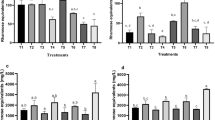Abstract
A rhamnolipid production strain newly isolated from oil-contaminated soil was identified as Pseudomonas aeruginosa GIM32 by its morphology and 16S rDNA sequence analysis. The effect of carbon source and carbon to nitrogen (C/N) ratio on rhamnolipids production was investigated. Palm oil was favorable as a carbon source for rhamnolipid production. The maximum biomass and rhamnolipid concentration were 8.24 g/L and 30.4 g/L, respectively, with an optimization medium containing 50 g/L palm oil and 5 g/L sodium nitrate. Molasses distillery wastewater as an unconventional substrate for rhamnolipid production was investigated. It was found that 2.6 g/L of rhamnolipids was produced; this amount was higher than that of past reports using wastewater as a substrate. In addition, 44% of the chemical oxygen demand of wastewater was removed at the same time under the optimization condition. Eleven kinds of different molecular weight rhamnolipid homologues were identified in the rhamnolipids obtained from molasses distillery wastewater by P. aeruginosa GIM32 by LC–MS analysis.






Similar content being viewed by others
References
Lang, S., & Wullbrandt, D. (1999). Applied Microbiology and Biotechnology, 51, 22–32.
Desai, J. D., & Banat, I. M. (1997). Microbiology and Molecular Biology Reviews, 61, 47–64.
Georgiou, G., Lin, S. C., & Sharma, M. M. (1992). Bio-Technology, 10, 60–65.
Mukherjee, S., Das, P., & Sen, R. (2006). Trends in Biotechnology, 24, 509–15.
Nandy, T., Shastry, S., & Kaul, S. N. (2002). Journal of Environmental Management, 65, 25–38.
Wilkie, A. C., Riedesel, K. J., & Owens, J. M. (2000). Biomass Bioenergy, 19, 63–102.
Shojaosadati, S. A., Khalilzadeh, R., Jalilzadeh, A., & Sanaei, H. R. (1999). Resources, Conservation and Recycling, 27, 125–38.
Jain, D. K., Collinsthompson, D. L., Lee, H., & Trevors, J. T. (1991). Journal of Microbiological Methods, 13, 271–79.
Dubois, M., Gilles, K. A., Hamilton, J. K., Rebers, P. A., & Smith, F. (1956). Analytical Chemistry, 28, 350–56.
Deziel, E., Lepine, F., Milot, S., & Villemur, R. (2000). Biochimica Et Biophysica Acta Molecular and Cell Biology of Lipids, 1485, 145–52.
Soberon-Chavez, G., Lepine, F., & Deziel, E. (2005). Applied Microbiology and Biotechnology, 68, 718–25.
Perfumo, A., Banat, I. M., Canganella, F., & Marchant, R. (2006). Applied Microbiology and Biotechnology, 72, 132–38.
Maier, R. M., & Soberon-Chavez, G. (2000). Applied Microbiology and Biotechnology, 54, 625–33.
Zhu, Y., Gan, J. J., Zhang, G. L., Yao, B., Zhu, W. J., & Meng, Q. (2007). Journal of Zhejiang University Science A, 8, 1514–20.
Sim, L., Ward, O. P., & Li, Z. Y. (1997). Journal of Industrial Microbiology & Biotechnology, 19, 232–38.
Abalos, A., Maximo, F., Manresa, M. A., & Bastida, J. (2002). Journal of Chemical Technology and Biotechnology, 77, 777–84.
Lee, K. M., Hwang, S. H., Ha, S. D., Jang, J. H., Lim, D. J., & Kong, J. Y. (2004). Biotechnology and Bioprocess Engineering, 9, 267–73.
Wu, J. Y., Yeh, K. L., Lu, W. B., Lin, C. L., & Chang, J. S. (2008). Bioresource Technology, 99, 1157–64.
Lee, Y., Lee, S. Y., & Yang, J. W. (1999). Bioscience, Biotechnology, and Biochemistry, 63, 946–47.
Dubey, K., & Juwarkar, A. (2001). World Journal of Microbiology & Biotechnology, 17, 61–69.
Patel, R. M., & Desai, A. J. (1997). Letters in Applied Microbiology, 25, 91–94.
Wei, Y. H., Chou, C. L., & Chang, J. S. (2005). Biochemical Engineering Journal, 27, 146–54.
Trummler, K., Effenberger, F., & Syldatk, C. (2003). European Journal of Lipid Science and Technology, 105, 563–71.
Jia, C. Y., Kang, R. J., Zhang, Y. H., Cong, W., & Cai, Z. L. (2007). Bioresource Technology, 98, 967–70.
Deziel, E., Lepine, F., Dennie, D., Boismenu, D., Mamer, O. A., & Villemur, R. (1999). Biochimica Et Biophysica Acta-Molecular and Cell Biology of Lipids, 1440, 244–52.
Thanomsub, B., Pumeechockchai, W., Limtrakul, A., Arunrattiyakorn, P., Petchleelaha, W., Nitoda, T., et al. (2006). Bioresource Technology, 97, 2457–61.
Acknowledgements
This research is supported by Teamwork Project of the Natural Science Foundation of Guangdong Province (9351007002000001), Guangdong Provincial Programs for Promoting the Integration of Production, Teaching and Research (2009B090300300299), and Guangdong-Hongkong Technology Cooperation Funding (2008A030700003).
Author information
Authors and Affiliations
Corresponding author
Rights and permissions
About this article
Cite this article
Li, Ah., Xu, My., Sun, W. et al. Rhamnolipid Production by Pseudomonas Aeruginosa GIM 32 Using Different Substrates Including Molasses Distillery Wastewater. Appl Biochem Biotechnol 163, 600–611 (2011). https://doi.org/10.1007/s12010-010-9066-1
Received:
Accepted:
Published:
Issue Date:
DOI: https://doi.org/10.1007/s12010-010-9066-1




